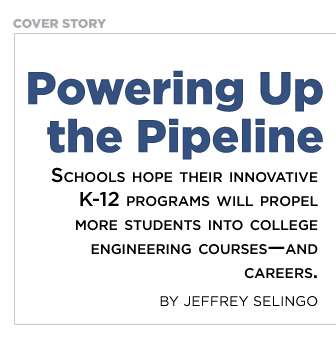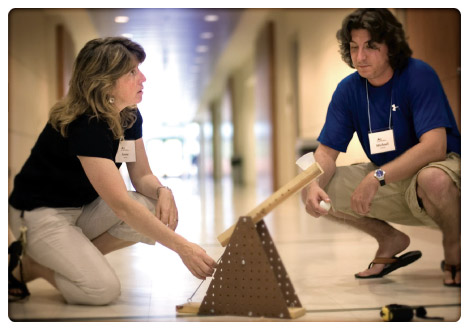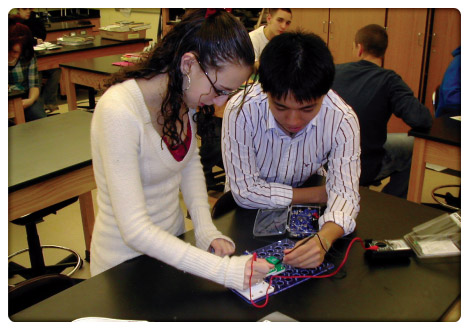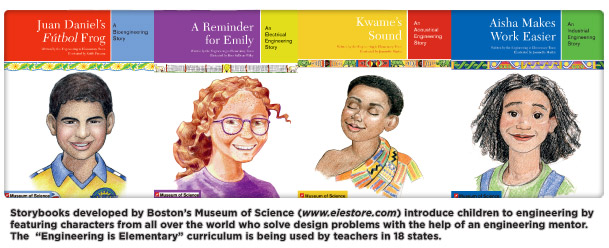Powering Up the Pipeline

It’s September, the start of the school year, and Dan Moriarty’s engineering students have their first assignment: “design the world’s best organizer.” Working in teams over the course of the next eight weeks, the students bounce around ideas, design mockups and build prototypes before presenting the products to their classmates. One team builds a chair for a kid’s bedroom with a storage compartment under the seat for laundry and other needs. Another group creates a portable silverware organizer for a kitchen drawer.
The task and ensuing results would seem pretty basic for a college engineering design course. These students are not undergraduates, however, but freshmen and sophomores at Whitman Hanson High School in Whitman, Mass. And their “professor” is one of dozens of K-12 educators in eight states teaching an introductory engineering class using a curriculum created by the National Center for Technological Literacy (NCTL) at Boston’s Museum of Science.
After finishing their organizers, Moriarty’s 9th and 10th graders move on to three other projects, each presented in eight-week segments. The ultimate goal is to provide students with a rudimentary overview of the different engineering disciplines, including materials, mechanical and electrical.
This “Engineering the Future” class is one of several efforts across the country to introduce engineering to elementary- and secondary-school pupils. The programs, which are growing in number and in some cases being established on a statewide basis, come in response to countless studies over the years that show if students encounter engineering early on in school, they are more likely to choose it as a career.
“Unless their parents are engineers, the kids really don’t have a clue what an engineer does,” says Moriarty, a physics teacher who debuted the course last year. Then, he had 20 students. This year, he teaches 50 students in two sections. Moriarty says he knows of four students who have decided to major in engineering in college as a result of the class.
Efforts to expand K-12 engineering education have taken on new urgency as academic and business leaders worry that a serious shortage of scientists and engineers threatens to erode America’s competitiveness. Those concerns were laid out in an influential 2005 report by the National Academies of Science called Rising Above the Gathering Storm. Its prominent panel of experts particularly bemoaned the sorry state of K-12 science and math education.
“The feeling is that the time has come to change the way we have been teaching math and science,” says NCTL Associate Director Yvonne Spicer. “In many ways, teaching engineering at a younger age makes sense. Kids love to solve problems, and at the core that’s what engineers do.”
Still, engineering is unlikely to become as much a fixture on the typical high school student’s schedule as English or history anytime soon. For starters, many school districts seem unwilling to incorporate engineering into the curriculum unless required by local or state officials, especially when they are under the gun to comply with federal No Child Left Behind Act mandates to raise reading and math scores. What’s more, most schools already struggle to recruit teachers who majored in math and science, let alone find those with the necessary skills to teach engineering classes.
“Unless a teacher or a principal thinks engineering should be a priority to teach,” Moriarty says, “it gets shoved to the bottom in many schools.”
Required Course?
That’s not the case in Massachusetts schools, at least not anymore. While 37 states include some form of engineering or technology education in their curriculum standards, only Massachusetts has designed a statewide assessment in technology/engineering similar to exams now administered in biology, chemistry and introductory physics. Beginning with the class of 2010, all Bay State students must pass one of the four science or engineering competency tests to graduate.
The testing requirement has pushed schools statewide to integrate engineering and technology into their lineup of science courses. NCTL’s Spicer, who was director of career and technical education in the high-performing Newton (Mass.) Public Schools, says that before Massachusetts introduced its new standards in 2001, engineering education had virtually no presence in science courses. Now, she says, Newton science and technology teachers team-teach an engineering course they co-developed that fulfills the freshman physics requirement.
“The projects assigned to students offer the chance to teach both physics and engineering skills,” Spicer explains. For example, in designing a mousetrap car, which uses a mousetrap spring to propel the vehicle, students learn about the coefficient of friction—a common science concept. That helps them choose wheel materials that will improve the car’s performance, an engineering design problem.
Moriarty says that by making science and math “come alive through engineering,” students also learn two other valuable skills: teamwork and communication. “It’s amazing how many of these students never worked in teams before and never had to make a formal presentation in front of a class,” Moriarty muses. When the group that designed the storage chair unveiled their creation, one impressed member of the audience—the school’s principal—asked if he could buy one. “The students didn’t make one to sell, but at least they were convincing,” Moriarty says with a laugh.
In addition to developing a curriculum for high-school teachers like Moriarty, NCTL has assembled a parallel set of courses for young children. Called “Engineering is Elementary,” the curriculum is currently being used by more than 700 Massachusetts teachers and their colleagues in 17 other states. The lesson plans focus on different areas of engineering and include a series of illustrated books with stories set in different countries. That allows youngsters to hone their reading skills along with their science acumen. One book, for instance, encourages readers to design a simple water filter like the story’s heroine, a young girl in India who created a pollution-free habitat for her turtle.
Teachers and officials at Boston’s Museum of Science say the elementary courses take advantage of children’s natural curiosity about building things and figuring out how they work. “If you want to find a born engineer,” says Ioannis Miaoulis, the museum’s president and director, “look for any 7-year-old.”
Promising Results
Early returns suggest that K-12 engineering programs like those offered by the Museum of Science seem to be having the desired effect of boosting interest in engineering careers. Take the results from Project Lead the Way, a nonprofit group that has developed an engineering curriculum for more than 1,700 middle and high schools in 46 states and the District of Columbia. A survey of 3,700 students in the program in 20 states found that 80 percent intend to enroll in college (10 percent higher than the national average). And 60 percent of them plan to study engineering, technology, math or science (about double the national average).
Indeed, an analysis of 100 college transcripts from Project Lead the Way participants who graduated from high school in 2005 or before showed that about 75 are studying engineering or technology. Moreover, they averaged a B or better in calculus, physics and chemistry.
“The reason we have so many students drop their engineering major in college is because they aren’t exposed to real science and engineering in high school,” says Anne Marie Spence, an assistant professor of mechanical engineering at the University of Maryland Baltimore County. Spence is a Project Lead the Way coordinator in the state, where 48 high schools and 12 middle schools have adopted the program. “The more things we can do like Project Lead the Way, the better we can prepare them for the rigors of college and in the end, produce more engineers.”
In the Kansas City area, Project Lead the Way is one of several K-12 engineering programs that are part of a 10-year, $22-million commitment by the Ewing Marion Kauffman Foundation to improve math and science education in schools there. “We see Kansas City as an incubation center,” says Dennis W. Cheek, the foundation’s vice president of education. “We develop things here, and if they work, then we roll them out nationally.”
Among the projects the foundation supports in the five-county region is Crayons to CAD, which has middle-school students apply science, technology and math concepts to real-world engineering problems by drawing blueprints and building scale models based on their plans. Then students bring their models to design/build competitions. Last year, the foundation assisted 28 high-school teams participating in FIRST Robotics, a program that has students design, assemble and test robots able to perform specific tasks.
Cheek says several students on the robotics teams joined only because of a friend, “but then as they saw the robots succeed, they got excited about the project.” He admits that while many of the students involved in the Kauffman-funded programs may not go on to pursue engineering careers, the experiences still will equip them with essential skills.
“Whether they become engineers or not, kids need to know a lot more about science, math, technology and engineering, period,” Cheek says.
Maryland officials are trying to accomplish just that by redesigning existing high schools to focus on science and technology. Eight counties have been awarded grants to consider establishing so-called STEM high schools, says the University of Maryland’s Spence. Her institution is partnering with Northrop Grumman in advising one STEM school already in the works in Baltimore County.
Specialized math and science academies have existed for decades. Today, at least 95 public high schools, with 37,000 students, focus their curricula on math, science and technology, according to the National Consortium for Specialized Secondary Schools. The difference in Maryland is that state officials want to make the same rigorous panoply of courses available to a broader student base than most “magnet” programs now reach.
As models, educators are looking to the existing math and science schools, most of which are two-year programs available to high-school juniors and seniors. Some of the academies, such as the Arkansas School for Mathematics, Sciences and the Arts, operate as stand-alone residential schools. Housed in a converted hospital in Hot Springs, the Arkansas school receives about $6 million annually from the state and enrolls 250 students who take a rigorous curriculum that includes such courses as biomedical physics and multivariable calculus. Other math and science schools, such as the Texas Academy of Mathematics and Science, operate on college campuses. Texas Academy students attend class at the University of North Texas and graduate with an associate’s degree as well as a high-school diploma.
Help Wanted
Demand for spots in such schools runs high. Most accept only about half of the applicants. That’s one reason why lawmakers in several states want to open more science-focused schools. But officials at some of the leading math and science academies worry that boosting the number of programs will only exacerbate the already difficult task of securing instructors qualified to teach the specialized courses.
“We’re having enough trouble as it is finding teachers,” says one school director, who requested anonymity. “We need to figure out how to educate more teachers first.”
That dilemma is currently the subject of intense debate among Washington policymakers. Last year, Congress asked the board that oversees the National Science Foundation to study the issue of teacher training in math and science. The science board appointed a special commission, which released a draft report in January. More focused than the Gathering Storm report, it called for the federal government to create a new national council to coordinate efforts to improve the teaching of science and math in schools and colleges; new standards for training math and science teachers; and an expansion of federal programs to encourage college students to pursue teaching careers.
The Commission on 21st Century Education in Science, Technology, Engineering and Mathematics also recommended the development of a single, national standard for the certification of math and science teachers, although the report did not go as far as to require school districts to hire only teachers who meet the certification standard.
In addition, the panel’s report called for the development of a national set of math and science curriculum standards, which the federal government would promote through financial incentives. The No Child Left Behind Act requires each state to develop science standards and test student achievement in them starting in the 2007-08 school year. (Unlike the annual tests in reading and math, science assessments will not count on a school’s annual “report card.”)
Promoting greater national consistency in school instruction is crucial to raising science aptitude, the report said, because the current system is “fractured and disjointed both within school districts and from state to state, placing at risk the ability of students to learn to high levels.”
Finally, the panel called for an expansion of federal programs to encourage math and science majors to become teachers. One model cited is the NSF’s Robert Noyce Scholarship Program, which awards up to $10,000 a year to undergraduates studying math and science who agree to become teachers after graduation. The draft report also suggested forgiveness of federal student loans for techies willing to train as teachers.
Another needed change is for college professors to promote K-12 teaching careers to their math and science students, contends Elaine Seymour, a research associate at the University of Colorado at Boulder and co-author of “Talking About Leaving: Why Undergraduates Leave the Sciences.”
“Faculty discourage students from entering K-12 math and science teaching,” Seymour said at a congressional committee hearing last year about increasing the number of qualified teachers in math and science. “And the students who decide to go on do not normally disclose their intention,” she adds, out of fear their professors “would take them less seriously.”
Massachusetts high school teacher Moriarty agrees that the only way the United States will ever produce more engineers is by encouraging some of them to forgo lucrative private-sector perches for the schoolhouse. “I tell my students they can make a lot of money as an engineer,” he says. “But they can also use those skills right here in the classroom teaching the next generation of engineers.”
Jeffrey Selingo is a freelance writer based in Washington, D.C.
Category: Cover Story Features





